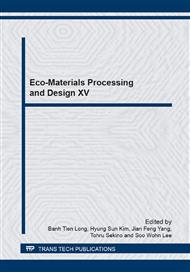p.203
p.209
p.213
p.217
p.221
p.225
p.231
p.235
p.239
Control of Indoor Suspended Microorganisms by UV and Photocatalytic Disinfection
Abstract:
This study presents the results of removal of Bacillus subtilis sp. and irradiated by UVA(3 μW/cm2) with three types of photo-catalysts (TiO2, ZnO, ZnO/laponite ball) to improve indoor air quality. The results showed that B. subtilis sp. was removed up to over 80% after 2 hours of reaction with all the photo-catalysts used and UVA irradiation. The B. subtilis sp. removal rate increased to more than 30 % when used both UVA and photo-catalysts, compared to that with only UVA control. Among the catalysts, ZnO/Laponite composite ball was found to have similar sterilization capacity to TiO2. Further study needs to figure out the optimum intensity of UVA and catalysts dosage to effectively disinfect and destroy the other microorganisms commonly found in indoor air environment.
Info:
Periodical:
Pages:
221-224
Citation:
Online since:
October 2014
Authors:
Keywords:
Price:
Сopyright:
© 2015 Trans Tech Publications Ltd. All Rights Reserved
Share:
Citation:


